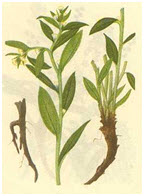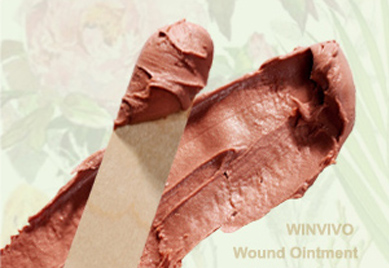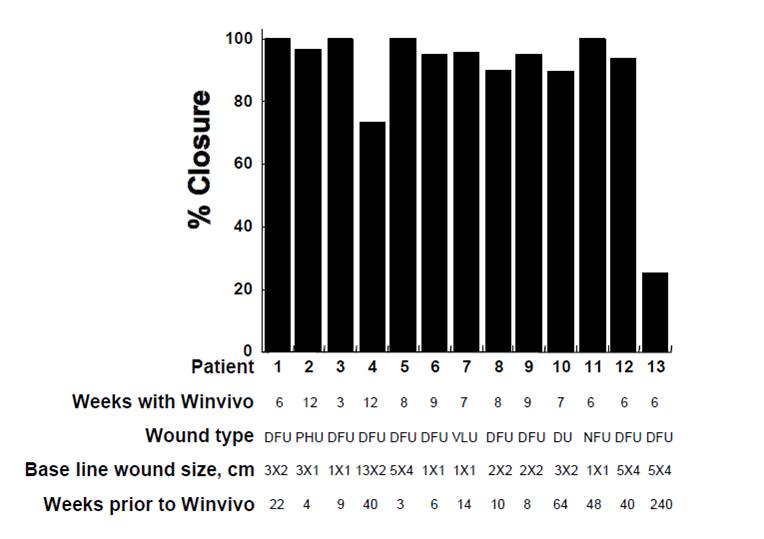Lithospermum root (Lithospermum erythrorhizon)
 The dried root of Lithospermum erythrorhizon is used in the preparation of the WINVIVO Wound Ointment.
The dried root of Lithospermum erythrorhizon is used in the preparation of the WINVIVO Wound Ointment.
Traditional Uses of Lithospermum Root
(Lithospermum erythrorhizon)
- The first record for medical use of lithospermum root has been appeared in the Chinese medical literature of The Divine Farmer’s Materia Medica (25 A.D. to 220 A.D).
- In traditional Chinese Medicine, lithospermum root has been used internally to cool blood, invigorate blood circulation and relieve toxin in the treatment of bleeding, incomplete eruption of measles, and externally to eliminate heat and toxins from the skin in the treatment of lesions, eczema, cervical erosion, vaginal itching and burns.
Modern Research - Lithospermum Root (Lithospermum erythrorhizon)
- Lithospermum root has been shown to be antimicrobial, antiviral, antifungal, and anti-inflammatory. It inhibits Bacillus dysenteriac, E. coli, Staphylococcus aureus and influenza viruses.
- It has marked anti-inflammatory effects and promotes healing. It has been used clinically to treat
psoriasis, burns, cervical erosion, and hepatitis.
Water Extract of Gromwell (Lithospermum erythrorhizon) Enhances Migration of Human Keratinocytes and Dermal Fibroblasts with Increased Lipid Synthesis in an in vitro Wound Scratch Model.
Skin Pharmacol Physiol. 2011 Oct 4; 25(2):57-64.
Kim H, Kim J, Park J, Kim SH, Uchida Y, Holleran WM, Cho Y.
Department of Medical Nutrition, Graduate School of East-West Medical Science, Kyung Hee University, Yongin-si, and Nutrex Co. Ltd., Seoul, Korea.Abstract
Background: Although organic extracts of gromwell (Lithospermum erythrorhizon) have been shown to promote wound healing, the wound healing effects of water extracts of gromwell (WG) that are commonly used in traditional remedies have not been elucidated.
Objective: We investigated whether WG promotes the migration and/or proliferation of cultured human keratinocytes (CHK) or dermal fibroblasts in parallel with increases in lipid synthesis during in vitro wound healing.
Methods: CHK or fibroblasts were treated with 1-1,000 μg/ml WG for up to 48 h following scratch wound formation. Cell migration was assessed by measuring coverage (in percent) from the wound margin, while cell proliferation and lipid synthesis were determined by [(3)H]thymidine incorporation into DNA fractions, and [(3)H]palmitate or [(3)H]serine incorporation into lipid fractions, respectively.
Results: Low-dose WG (1 μg/ml) enhanced the wound coverage for both CHK and fibroblasts at 24 h, while cell proliferation was not altered in either cell types. Synthesis of both total lipids and individual lipid classes, including phospholipids, sphingolipids and neutral lipids, were found to be increased at 24 h in CHK treated with 1 μg/ml WG; in similarly treated fibroblasts, only the syntheses of sphingolipids (such as ceramides and glucosylceramides), but not other lipid species, were significantly increased. In contrast, a higher dose of WG (10-1,000 μg/ml) did not enhance wound coverage, and 100 μg/ml WG neither altered cell proliferation nor lipid synthesis in both CHK and fibroblasts.
Conclusion: Low-dose WG (1 μg/ml) enhances the migration of both CHK and fibroblasts with increased lipid synthesis in an in vitro wound scratch model.
Dermocosmetics for dry skin: a new role for botanical extracts.
Skin Pharmacol Physiol. 2011; 24(6):289-93. Epub 2011 Jun 25.
Casetti F, Wölfle U, Gehring W, Schempp CM.
Competence Center skintegral, Department of Dermatology, University Medical Center Freiburg, Freiburg, Germany.
Abstract
Dry skin is associated with a disturbed skin barrier and reduced formation of epidermal proteins and lipids. During recent years, skin-barrier-reinforcing properties of some botanical compounds have been described. Searching the PubMed database revealed 9 botanical extracts that specifically improve skin barrier and/or promote keratinocyte differentiation in vivo after topical application. The topical application of Aloe vera (leaf gel), Betula alba (birch bark extract), Helianthus annuus (sunflower oleodistillate), Hypericum perforatum (St. John's wort extract), Lithospermum erythrorhizon (root extract), Piptadenia colubrina (angico-branco extract) and Simarouba amara (bitter wood extract) increased skin hydration, reduced the transepidermal water loss, or promoted keratinocyte differentiation in humans in vivo. The topical application of Rubia cordifolia root extract and rose oil obtained from Rosa spp. flowers stimulated keratinocyte differentiation in mouse models. The underlying mechanisms of these effects are discussed. It is concluded that some botanical compounds display skin-barrier-reinforcing properties that may be used in dermocosmetics for dry skin. However, more investigations on the mode of action and more vehicle-controlled studies are required.
Shikonin protects mouse brain against cerebral ischemia/reperfusion injury through its antioxidant activity.
Eur J Pharmacol. 2010 Sep 25; 643(2-3):211-7. Epub 2010 Jun 30.
Wang Z, Liu T, Gan L, Wang T, Yuan X, Zhang B, Chen H, Zheng Q.
Key Laboratory of Xinjiang Endemic Phytomedicine Resources, Ministry of Education, School of Pharmacy, Shihezi University, Shihezi, China.
Abstract
The aim of our study was to investigate the neuroprotective properties of shikonin, a naphthoquinone pigment isolated from the roots of the traditional Chinese herb Lithospermum erythrorhizon. In the present study, mice were divided randomly into sham, model, shikonin and edaravone-treated groups. Shikonin (50, 25, and 12.5mg/kg, i.g.) or maize oil was administered three times before ischemia and once at 2h after the onset of ischemia. Mice were anesthetized with chloral hydrate and subjected to middle cerebral artery 2h of occlusion and then 22h of reperfusion. Different antioxidant assays were employed in order to evaluate the antioxidant activities of shikonin in vitro. Neurological deficit, infarct size, histopathology changes and oxidative stress markers were evaluated after 22h of reperfusion. In comparison with the model group, treatment with shikonin significantly decreased neurological deficit scores, infarct size, the levels of malondialdehyde(MDA), carbonyl and reactive oxygen species, and attenuated neuronal damage, up-regulated superoxide dismutase (SOD), catalase, glutathione peroxidase (GSH-Px) activities and reduced glutathione (GSH)/glutathione disulfide (GSSG) ratio. Taken together, these results suggested that the neuroprotective effects of shikonin against cerebral ischemia/reperfusion injury may be attributed to its antioxidant effects.
WINVIVO Wound Ointment:
Multi-Functional Botanical Therapy
Clinical Studies
- Difficult-to-Heal Wounds
Clinical Case Reports
- Cases #1A-6A
- Cases #1B-8B
- Cases #1C-7C
- Cases #1D-4D
- Cases #1E-2E
- Cases #1F-6F
- Cases #1G-5G
- Case #1H
- Case Series #1I
- Case Series #1J
Privacy Policy | Disclaimer | Return Policy | Contact Us
© 2009-2021 WinVivo Corporation All Rights Reserved




